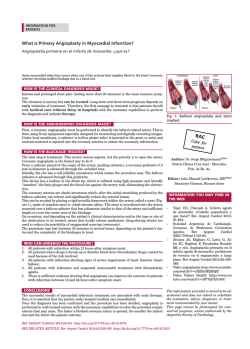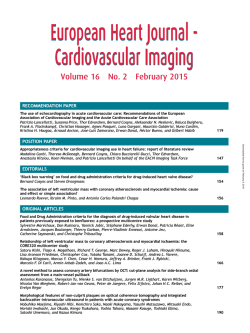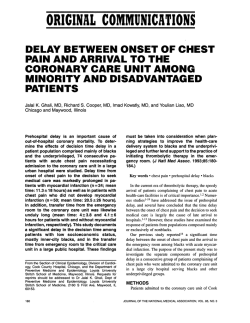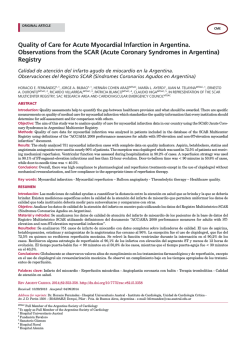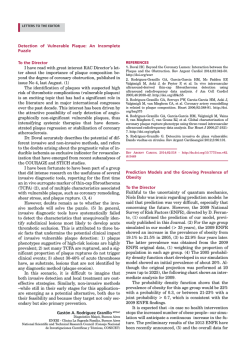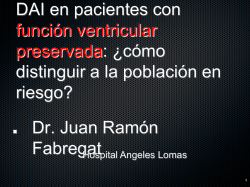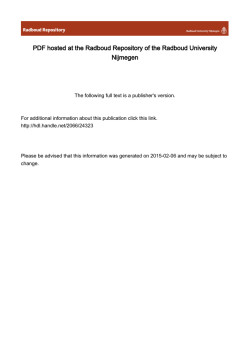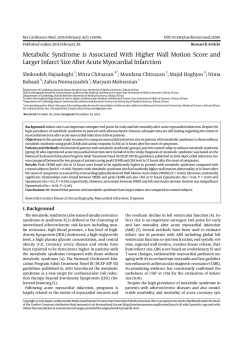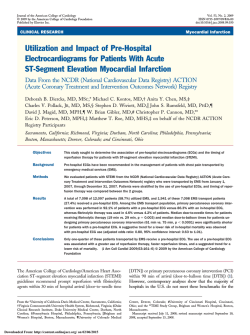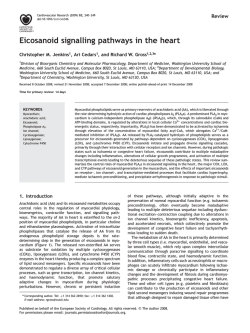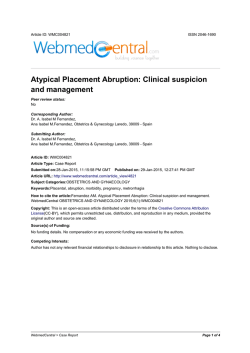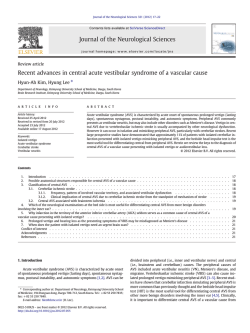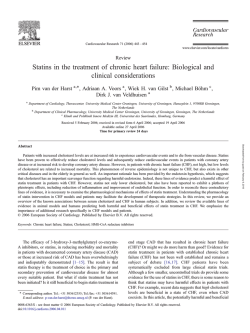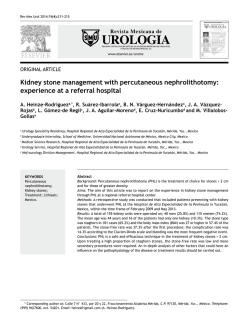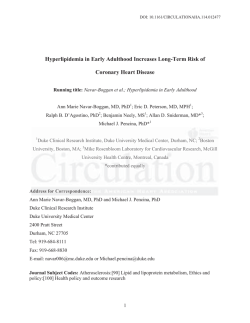
Primary Percutaneous Coronary intervention in acute Myocardial
ORIGINAL ARTICLE Primary Percutaneous Coronary Intervention in Acute Myocardial Infarction: Long-Term Predictors of Adverse Events Angioplastia primaria en el infarto agudo de miocardio: predictores de eventos en el seguimiento a largo plazo JOSÉ A. ÁLVAREZMTSAC, 1, 2, GUILLERMO MIGLIAROMTSAC, 1, 2, GUSTAVO LEIVAMTSAC, 1, 2, JORGE G. ALLINMTSAC, 1, PABLO BAGLIONI1, MARÍA LUZ FERNÁNDEZ RECALDE3, HORACIO AVACA†, 3, FELIPE DEKETELE†, 4 ABSTRACT Introduction: Acute myocardial infarction (AMI) is one of the leading causes of cardiovascular death. Reperfusion treatments performed within the first hours have contributed to produce a significant reduction in mortality. In our country, there are no long-term follow-up registries of AMI patients treated with primary percutaneous coronary intervention (PCI). Objectives: The aim of this study is to evaluate the in-hospital results and long-term outcome of ST-segment elevation AMI (STEMI) patients undergoing primary PCI and their correlation with the main clinical and therapeutic variables applied in different decades (19932002 vs. 2003-2012). Methods: We performed an observational and retrospective study of all STEMI patients undergoing primary PCI in two community hospitals between 1993 and 2012. Results: The study included 851 patients consecutively admitted between 1993 and 2012. Mean age was 61 ± 12 years and median followup was 7.8 years in 85% of the population. In-hospital mortality was 6% and 1.6% when patients with shock at admission were excluded. It was independently associated with age (OR 1.06, CI 1.03-1.09; p < 0.001), female sex (OR 3.1, CI 1.5-6.2; p < 0.002), diabetes mellitus (OR 3.9, CI 1.86-8; p < 0.001) and three-vessel disease (OR 4.3, CI 2.1-8.6; p < 0.001). Conversely, final TIMI grade 3 flow predicted lower in-hospital mortality (OR 0.28, CI 0.08-0.11; p < 0.008). During follow-up, overall mortality was 14.3% and the independent predictors were age (OR 3.1, CI 1.8-5.5; p < 0.001), diabetes mellitus (OR 2.3, CI 1.25-4.3; p < 0.007) and Killip and Kimball (KK) class C or D at admission (OR 4, CI 1.7-9; p < 0.001); stent implant was associated with lower overall long-term mortality (OR 0.35, CI 0.21-0.6; p < 0.001). Conclusions: In this group of STEMI patients, the adequate use of primary PCI and the high rate of patients at long-term follow-up allowed the collection of favorable in-hospital and long-term results. Advanced age at the moment of STEMI, diabetes mellitus, female sex and multiple vessel disease were predictors of in-hospital mortality, while age, diabetes mellitus and KK class C or D were independent predictors of mortality during follow-up. Patients treated during the second decade showed a non-significant trend towards reduced inhospital mortality compared with those of the first decade. Key words: Primary Angioplasty - Myocardial Infarction - Follow-up Studies - Mortality - Registries, Argentina. RESUMEN Introducción: El infarto agudo de miocardio (IAM) es una de las principales causas de muerte cardiovascular. Los tratamientos de reperfusión, aplicados dentro de las primeras horas del evento, han contribuido a disminuir significativamente esa mortalidad. No existen en nuestro país registros con seguimiento a largo plazo de pacientes con IAM tratados con angioplastia transluminal coronaria primaria (ATCP). Objetivos: Evaluar los resultados intrahospitalarios y el pronóstico alejado de pacientes sometidos a ATCP por IAM con supradesnivel del segmento ST (IAMCST) y su relación con las principales variables clínicas y terapéuticas aplicadas en diferentes décadas (1993-2002 vs. 2003-2012). Material y métodos: Estudio observacional y retrospectivo de todos los pacientes con diagnóstico de IAMCST a los que se les realizó una ATCP en dos hospitales de comunidad entre los años 1993 y 2012. Resultados: Se incluyeron 851 pacientes ingresados consecutivamente entre los años 1993 y 2012. La edad promedio fue de 61±12 años y la mediana de seguimiento fue de 7,8 años en el 85% de la población. La mortalidad intrahospitalaria total fue del 6%y del 1,6% excluidos los pacientes con shock al ingreso; las variables independientes asociadas fueron la edad (OR 1,06, IC 1,03-1,09; p< 0,001), el sexo femenino (OR 3,1, IC 1,5-6,2; p< 0,002), la diabetes mellitus (OR 3,9, IC 1,86-8; p< 0,001) y la enfermedad de tres vasos REV ARGENT CARDIOL 2014;82:359-365. http://dx.doi.org/10.7775/rac.v82.i5.3613 SEE RELATED ARTICLE: Rev Argent Cardiol 2014;82:341-342. http://dx.doi.org/10.7775/rac.v82.i5.4849 Received: 12/05/2013 Accepted: 03/05/2014 Address for reprints: Dr. José A. Álvarez - Perdriel 74 - (C1280AEB) CABA, Argentina - Fax: 54 11 4309-6400 ext 2361 e-mail: [email protected] MTSAC Full Member of the Argentine Society of Cardiology To apply as full member of the Argentine Society of Cardiology 1 Department of Interventional Cardiology - Hospital Británico de Buenos Aires 2 Department of Interventional Cardiology - Hospital Alemán 3 Department of Cardiology - Hospital Británico de Buenos Aires 4 Department of Cardiology- Hospital Alemán † 360 ARGENTINE JOURNAL OF CARDIOLOGY / VOL 82 Nº 5 / OCTOBER 2014 coronarios (OR 4,3, IC 2,1-8,6; p< 0,001); el flujo final TIMI 3 fue una variable predictora de menor mortalidad intrahospitalaria(OR 0,28, IC 0,08-0,11; p< 0,008). La mortalidad global en el seguimiento fue del 14,3% y los predictores independientes fueron la edad (OR 3,1, IC 1,8-5,5; p< 0,001), la diabetes mellitas (OR 2,3, IC 1,25-4,3; p< 0,007) y la clase C o D de la clasificación de Killip y Kimball (KK) al ingreso (OR 4, IC 1,7-9; p< 0,001); la utilización de stent se asoció con menor mortalidad global alejada (OR 0,35, IC 0,21-0,6; p< 0,001). Conclusiones: En este grupo de pacientes con IAMCST, la ATCP aplicada adecuadamente y una elevada tasa de seguimiento alejado permitió obtener resultados intrahospitalarios favorables que se mantienen en el largo plazo. La edad avanzada al momento del IAMCST, la diabetes mellitus, el sexo femenino y la presencia de lesiones significativas en más de un vaso epicárdico mayor fueron los predictores de mortalidad intrahospitalaria, mientras que los dos primeros (edad y diabetes mellitus) y el KK Co D fueron predictores independientes de mortalidad en el seguimiento. Los pacientes asistidos durante la segunda década mostraron una tendencia no significativa a menor mortalidad intrahospitalaria en comparación con los de la primera década.. Palabras clave: Angioplastia primaria- Infarto del miocardio- Estudios de seguimiento- Mortalidad- Registros- Argentina. Abbreviations ASA Acetylsalicylic acid (aspirin) PCI Percutaneous coronary intervention LBBB Left bundle-branch block CABGSCoronary artery bypass graft surgery DM Diabetes mellitus MACE Major adverse coronary event In our country, there are no central and continuous epidemiological registries to estimate the real annual rate of myocardial infarctions. However, by extrapolating published results, we may infer a rate of about 80 cases per 100 000 persons per year, with an in-hospital mortality between 6% and 12%. (1-4) Early reperfusion therapy, either mechanical or pharmacological, has shown a significant reduction in ST-segment elevation myocardial infarction (STEMI) mortality. Primary percutaneous coronary intervention (PCI), timely performed at institutions with qualified staff, is the therapeutic strategy of choice (Class I, Level of evidence A) recommended by the most important American and European guidelines. (5, 6) The aim of this study is the analysis of a continuous registry of all primary PCI performed during 20 years at two community hospitals in Argentina, to evaluate the in-hospital results and long-term outcome of STsegment elevation myocardial infarction (STEMI) patients undergoing primary PCI, and their correlation with the main clinical and therapeutic variables applied in different decades (1993-2002 vs. 2003-2012). METHODS Study design and population This observational and retrospective study included all STEMI patients undergoing primary PCI at the Hospital Alemán and the Hospital Británico de Buenos Aires between 1993 and 2012. The objectives were defined and the variables were prospectively selected. Patients undergoing primary PCI before 2008 were retrospectively identified from the databases of both catheterization laboratories. Since 2008, patients were prospectively included. The main clinical and cardiovascular characteristics at admission, times to reperfusion and in-hospital outcome were analyzed from the information available in the clinical records. Procedure-related information and outcomes were obtained from the electronic databases of both catheterization laboratories. Clinical follow-up was performed by tel- HTHypertension AMI Acute myocardial infarction STEMI ST-segment elevation myocardial infarction KK Killip and Kimball DTBTDoor-to-balloon-time ephone contact or medical visits, using a semi-structured questionnaire. We analyzed the incidence of in hospital global mortality and out-of-hospital total death, new acute myocardial infarction, stroke, need for repeat revascularization by CABGS or PCI, and the combined major adverse cardiac events (MACCE). Definitions STEMI was defined as the presence of myocardial ischemia lasting < 12 hours with ST-segment elevation at the J point ≥ 2 mm in at least two contiguous leads or the presence of new or presumed new complete left bundle branch block (LBBB) and release of biomarkers of cardiac necrosis, specifically troponin T. Patients with AMI lasting longer than 12 hours and those who had received previous fibrinolytic therapy, with or without reperfusion criteria were excluded. Multiple-vessel disease was considered as the presence of ≥ 70% stenosis in a major epicardial vessel in a non-infarct related territory. Diabetes mellitus (DM) was defined as the presence of this condition at admission in patients with antidiabetic and/or on a dietary treatment. Door-to-balloon time (DTBT) was defined as the time interval between the first contact with medical or administrative staff and guide wire passage across the coronary artery obstruction. The procedure was considered successful when TIMI grade 3 flow was obtained according to the discretion of the attending operator. The need for a repeat PCI or CABGS was left at the discretion of the treating physician. Statistical analysis Continuous variables were presented as mean ± standard deviation, or median and interquartile range (IQR 25-75), according to their normal or non-normal distribution, and groups were respectively compared using Student’s t test or the non-parametric Wilcoxon test. Categorical variables were expressed as percentages, and were compared using 361 PREDICTORS OF EVENTS IN PRIMARY PERCUTANEOUS CORONARY INTERVENTION / José A. Álvarez et al. Pearson’s chi square test. The odds ratio (OR) was also calculated with its corresponding 95% confidence interval (95% CI). Univariate and multivariate logistic regression models were used with manual variable insertion to establish which were independently associated with the pre-established end points. A p value < 0.1 or the presence of confounders was considered to include variables in the multiple regression analysis. A two-tailed p value < 0.05 was considered statistically significant. All the statistical calculations were performed using SPSS 15.0 software package®. RESULTS General characteristics The analysis included 851 patients consecutively admitted between January 1993 and December 2012 in two community hospitals. Mean age was 61 ± 12 years, and 77% were men. The main clinical and angiographic characteristics at admission are detailed in Table 1. Anterior wall AMI occurred in 49% of patients, 82.7% were admitted with Killip and Kimball (KK) class A and 7.1% were in cardiogenic shock. The left anterior descending coronary artery was the culprit vessel in almost 50% of cases, and 50% of patients had significant stenosis in ≥ 2 epicardial coronary vessels. When patients studied during the first dec- ade were compared with those of the second decade (n = 295 vs. n = 556, respectively), the percentage of elderly patients and women was higher and the incidence of dyslipidemia and smoking habits was lower in the latter decade. Also, the percentage of anterior wall infarctions and of patients with single vessel disease was lower during the second decade (see Table 1). In-hospital outcomes The therapeutic strategy used and the main in-hospital outcomes are described in Table 2. The DTBT was only recorded in 692 patients (82% of the population), and was ≤ 120 minutes in 80% of these patients. Stents were used in 85.6% of cases. One third of the patients received glycoprotein (GP) IIb/IIIa inhibitors during the procedure. Overall in-hospital mortality was 6% and 1.6% excluding patients admitted with cardiogenic shock. When the results obtained in both decades were compared, the most contemporary patients had lower DTBT, higher use of stents and GP IIb/IIIa inhibitors and better final TIMI flow. The main variables associated with higher in-hospital mortality were age ≥ 75 years [OR 1.07 (95% CI: 1.01-1.13); p = 0.015], female gender [11.9% vs. 4.3%, Table 1. Demographic, clinical and angiographic characteristics of the population at admission Total First decade Total Second decade Population, n 851 295 556 Age, years 61 60 61 (53-69) (52-68) (54-70) (IQR 25-75%) OR (95% CI) p N/C 0.02 % (n/n total) % (n/n total) % (n/n total) Age ≥75 years 13 (110/851) 9.15 (27/295) 14.93 (83/556) 0.57 (0.36-0.91) 0.016 Male gender 77 (654/851) 81.69 (241/295) 74.28 (413/556) 1.52 (1.07-2.16) 0.018 HT 47.5 (403/851) 48.81 (144/295) 46.58 (259/556) 1.09 (0.82-1.45) 0.53 DLP 45.4 (385/851) 52.54 (155/295) 41.36 (230/556) 1.57 (1.18-2.09) 0.002 SH 50.8 (431/851) 57.96 (171/295) 46.76 (260/556) 1.57 (1.18-2.09) 0.002 DM 11.3 (96/851) 10.51 (31/295) 11.69 (65/556) 0.88 (0.56-1.39) 0.6 History of cardiovascular diseases Previous angina 5.7 (48/851) 5.42 (16/295) 5.75 (32/556) 0.93 (0.5-1.73) 0.83 Previous AMI 10.8 (92/851) 8.81 (26/295) 11.87 (66/556) 0.71 (0.44-1.15) 0.17 Previous PCI 6.7 (57/851) 6.1 (18/295) 7.01 (39/556) 0.86 (0.48-1.53) 0.6 Previous CABGS 2.8 (24/851) 3.39 (10/295) 2.51 (14/556) 1.35 (0.59-3.1) 0.46 Killip& Kimball class at admission A 82.6 (703/851) 78.98 (234/295) 84.17 (469/556) 0.7 (0.48-1.01) 0.06 B. 8.6 (73/851) 9.83 (29/295) 7.73 (44/556) 1.3 (0.79-2.13) 0.29 C 1.6 (14/851) 2.37 (7/295) 1.26 (7/556) 1.01 (0.66-5.50) 0.22 D 7.1 (61/851) 8.13 (25/295) 6.29 (36/556) 1.32 (0.77-2.26) 0.31 47.1 (401/851) 56.95 (168/295) 41.91 (233/556) 1.83 (1.37-2.44) < 0.001 1 49.9 (425/851) 57.6 (170/295) 45.8 (255/556) 1.54 (1.16-2.05) 0.003 2 30 (263/851) 25.4 (75/295) 33 (188/556) 0.72 (0.53-0.99) 0.05 3 19.1 (163/851) 16.27 (48/295) 20 (115/556) 0.75 (0.52-1.09) 0.13 1.3 (11/851) 1.35 (4/295) 1.26 (7/556) 1.03 (0.7-1.12) 0.9 Anterior wall AMI N of vessels CABGS IQR: Interquartile range. HT: Hypertension. DLP: Dyslipidemia. SH: Smoking habits. DM: Diabetes mellitus. AMI: Acute myocardial infarction. 362 ARGENTINE JOURNAL OF CARDIOLOGY / VOL 82 Nº 5 / OCTOBER 2014 OR 3 (95% CI: 1.68-5,3); p < 0.001], DM [OR 3.8 (95% CI: 2-7.2); p < 0.001], hypertension (HT) [OR 1.7 (95% CI: 0.95-3); p = 0.07], KK class at admission > A [OR 9.3 (95% CI: 4.2-20.6); p < 0.001] and presence of significant stenosis in more than one major epicardial coronary vessel [OR 3.2 (95% CI: 1.7-6.3); p < 0.001]. Use of stents during primary PCI [OR 0.5 (95% CI: 0.25-0.98); p = 0.044] and a final TIMI grade 3 flow [OR 0.1 (95% CI: 0.07-0.3); p < 0.001] were associated with lower in-hospital mortality. However, in the multivariate analysis, only age ≥ 75 years [OR 1.06 (95% CI: 1.03-1.09); p < 0.001], DM [OR 3.9 (95% IC: 1.86-8); p < 0.001], female gender [OR 3.1 (95% CI: 1.5-6.2); p = 0.002] and severe 3-vessel disease [OR 4.3 (95% CI: 2.1-8.6); p < 0.001] were predictors of higher in-hospital mortality. Final TIMI grade 3 flow was independently associated with lower mortality [OR 0.28 (95% CI: 0.08-0.11); p = 0.008] (Table 3). Follow-up. Predictors of mortality and survival analysis Clinical follow-up was performed in 85.4% of the population during a median period of 7.8 years (IQR 3.5-10.2). Follow-up lasting more than 10 years was completed in 26.2% of patients. Patients were treated with aspirin (ASA) associated with a statin in 88.3% of cases, beta blockers in 90% and angiotensin converting enzyme inhibitors in 68% (Figure 1). The incidence of MACE was 35.1%, AMI occurred in 6.2% of patients and repeat revascularization was performed in 29% of cases (CABGS 6.2% and PCI 22.8%). Overall mortality during follow-up was 14.3% (Figure 2). The independent predictors of out-of-hospital mortality were age ≥ 75 years at the moment of STEMI [OR 3.1 (95% CI: 1.8-5.5); p < 0.001], DM [OR 2.3 (95% CI: 1.25-4.3); p = 0.007] and KK class C or D at admission [OR 4 (95% CI: 1.7-9); p = 0.001] (Table 4). Use of stent was associated with lower mortality after discharge [OR 0.35 (95% CI: 0.21-0.6); p < 0.001]. All these variables, with the exception of KK class at admission, were associated with MACE with OR of 3.1 [(95% CI: 1.8-5.35); p < 0.001], OR 2.4 [(95% CI:1.34.3); p = 0.005] and OR 0.33 [(95% CI: 0.2-0.6); p < 0.001], respectively. The need of repeat revascularization was associated with the presence of significant ≥ 2-vessel disease in the coronary angiography at admission [OR 2.5 (95% CI: 2.25-5.4); p = 0.001], and Table 2. In-hospital outcomes Total population% (n/n total) First decade% (n/n total) Second decade% (n/n total) OR (95% CI) p DTBT ≤ 120 min 80.49 (557/692) 57 (133/231) 92 (424/461) 0.12 (0.08-0.18) < 0.0001 Use of stent 85.8 (727/851) 74.57 (220/295) 91.18 (507/556) 0.27 (0.17-0.4) < 0.001 3 (25/851) 0.68 (2/295) 4.13 (23/556) 0.15 (0.03-0.67) 0.004 Use of GPIIb/IIIa inhibitors 30.3 (257/851) 40.67 (120/295) 24.64 (137/556) 2.09 (1.54-2.84) 0.001 Final TIMI grade 3 flow 93.88 (799/851) 91.18 (269/295) 95.32 (530/556) 0.5 (0.29-0.89) 0.02 6 (51/851) 7.45 (22/295) 5.21 (29/556) 1.47 (0.83-2.61) 0.18 1.77 (14/792) 2.21 (6/271) 1.54 (8/521) 1.46 (0.5-4.3) 0.48 Thromboaspiration Overall IH mortality IH mortality KK A, B or C DTBT: Door-to-balloon-time. GP: Glycoprotein. IH: In-hospital. KK: Killip and Kimball. A. Univariate analysis Variables OR 95% CI p >75 years old 1.07 1.01-1.13 < 0.015 Female gender 3 1.68-5.3 < 0.001 Diabetes mellitus 3.8 2-7.2 < 0.001 Hypertension 1.7 0.95-3 < 0.07 KK > A at admission 9.3 4.2-20.6 < 0.001 ≥2-vessel disease 3.2 1.7-6.3 < 0.001 Use of stent 0.5 0.25-0.98 < 0.044 Final TIMI grade 3 flow 0.1 0.07-0.3 < 0.001 >75 years old 1.06 1.03-1.09 < 0.001 Female sex 3.1 1.5-6.2 < 0.002 Diabetes mellitus 3.9 1.86-8 < 0.001 >2 vessel disease 4.3 2.1-8.6 < 0.001 Final TIMI grade 3 flow 0.28 0.08-0.11 < 0.008 B. Multivariate analysis KK: Killip and Kimball. Table 3. Predictors of in-hospital mortality 363 PREDICTORS OF EVENTS IN PRIMARY PERCUTANEOUS CORONARY INTERVENTION / José A. Álvarez et al. anterior wall infarction was related with a lower rate of reinterventions during follow-up [OR 0.6 (95% CI: 0.4-0.98); p = 0.037]. DISCUSSION The first catheter-based intervention in a STEMI setting was performed by Galiano et al. (from the Hospital de Clínicas de San Pablo, Brazil). During a diagnostic coronary angiography in a patient with cardiogenic shock, they successfully reopened the right coronary artery with a Sones catheter. (7) Since the introduction of percutaneous transluminal coronary angiography by Andreas Grüntzig in 1977, new therapeutic options emerged for the treatment of coronary artery disease in all its clinical scenarios. (8) In 1981, Meyer et al. introduced coronary angioplasty after intracoronary fibrinolysis for STEMI, with acceptable results; (9), however, one year later, Hart100 90 80 70 60 % 50 40 30 20 10 0 94 90 88 88.3 StatinsA ASA SA+Statins 68 ASA Aspirin BB ACEI Fig. 1. Follow-up medication. BB: Beta blockers.ACEI: Angiotensinconverting enzyme inhibitor. ASA: Acetyl salicylic acid 40 35.1 35 30 25 22.8 % 20 14.3 15 10 6.2 5 0 6.2 1.9 AMI IAMS Stroke troke PCI CABGS Mortality Total Fig. 2. Major adverse cardiovascular events during follow-up. AMI: Acute myocardial infarction. PCI: Percutaneous coronary intervention. CABGS: Coronary artery bypass graft surgery. Table 4. Predictors of in-hospital mortality Variable zler et al. were the first ones to perform mechanical reperfusion using balloon angioplasty, increasing the opening efficacy of the occluded artery with reduced risk of bleeding. (10) Since then, numerous clinical trials were performed comparing both reperfusion strategies (11-13) with different results. The incorporation of stent to angioplasty at the end of the nineties resulted in significant benefits of this technique compared to fibrinolysis in terms of mortality, non-fatal AMI and stroke. (14-18) Our country was a pioneer in the use of this new concept of mechanical reperfusion. In 1982, Rodriguez et al. presented the first publication on the usefulness of PCI in the AMI setting (19) and the first PCI registries and clinical trials started in Argentina at the beginning of the nineties. (20-24) Our registry was initiated in this setting 20 years ago in two community general hospitals and has been going on without interruption, being an original study concerning current published reports, with a mean follow-up of almost 8 years associated with a significant percentage of patients evaluated throughout its course. Population characteristics are similar to those of domestic and international registries published in this clinical scenario, with high prevalence of elderly patients and female gender during the second decade. Of interest, the low percentage of patients with DM in our registry (11.3%) might be due to the diagnostic criteria used, although in the DESERT cooperative study, which included 6298 STEMI patients from 11 randomized clinical trials, the percentage of patients with DM was 15.4%. (25) The clinical presentation is not different from the one published in other studies, with a high percentage of patients with KK class A and with the left anterior descending coronary artery as the culprit vessels in almost half of the cases. The lower incidence of anterior wall infarctions in patients treated during the second decade may be related to the fact that at the beginning of PCI procedures, only these patients were referred to the catheterization laboratory. A DTBT ≤ 120 minutes was achieved in more than 80% of cases, with a significant difference in patients treated in the second decade, probably due to the use of coordinated protocols for patient transportation, OR 95% CI p Age ≥75 years 3.1 1.8-5.5 < 0.001 Diabetes mellitus 2.3 1.25-4.3 < 0.007 4 1.7-9 < 0.001 0.35 0.21-0.6 < 0.001 Age ≥75 years 3.1 1.8-5.35 < 0.001 Diabetes mellitus 2.4 1.3-4.3 < 0.005 Use of stent 0.33 0.2-0.6 < 0.001 ≥2-vessel disease 2.43 1.7-3.6 < 0.001 KK class C or D at admission Use of stent MACE MACE: major adverse cardiovascular events. KK: Killip and Kimball. 364 early diagnosis of patients presenting spontaneously and direct transfer of patients to the catheterization laboratory whenever possible. Although the use of stents is lower than that reported by the international literature, if only patients presenting with STEMI during the last decade of the registry are analyzed, stents were used in almost 92% of primary PCI, reflecting the technical evolution of the interventions and endovascular devices currently available. Moreover, in the Coronary Angioplasty Registry in Argentina CONAREC XVI, published in 2007, the use of stent was 88.5% in primary PCI. (26) The administration of GP IIb/IIIa inhibitors started in 1997 at our institutions when favorable results in the subgroup of STEMI patients in the EPIC trial (27) were published; abciximab (Reopro®) was the drug of choice and the percentage of patients receiving this GP IIb/IIIa inhibitor is higher than the mean value between 7% and 12% recently reported for our country. (28) However, these values are far lower than those published by the National Cardiovascular Data Registry (NCDR) in the USA, where this drug is used in 70% of STEMI cases. (29) Overall in-hospital mortality rate (6%) is similar to international reference results; the last NCDR publication reports a mortality of 5.5% and the European Association of Percutaneous Coronary Interventions (EAPCI) communicates values between 2.7% and 8%, depending on the European country. (6, 29) The difference in in-hospital mortality between the first and second decade did not reach statistical significance (7.5% vs. 5.2%; p = 0.18). However, in the most contemporary patients, the groups showed differences in the percentage of patients ≥ 75 years, female gender, anterior wall infarction and single vessel disease, though the percentage of patients admitted with cardiogenic shock was similar (8.2% in the first decade vs. 6.3% in the second decade; p = 0.3). This difference in in-hospital mortality might be due to the implementation of strategies for improving quality of care, which produced a significant reduction in the DTBT, from 147.8 ± 78 min to 100.3 ± 49 min in the first versus the second decade, respectively (p > 0.001). In the second decade, 91% of the patients underwent primary PCI within 120 minutes after admission versus 57.6% of the patients treated in the first decade (p < 0.001). The high compliance of AMI surviving patients to conventional medical treatment is worth noting, with values near 85-90% for the use of aspirin, beta blockers and statins. In 2006, Tuppin et al. reported a rate of pharmacological adherence of 80-90% in a French population followed-up for 6 months after AMI. (30) However, Zhang et al. found a compliance rate of 6468% at 1 year for these drugs in the 2008 Medicare registry. (31) Overall long-term mortality (14.3%) and MACCE (35.1%) were low, the latter mainly due to the need for repeat revascularization (PCI 22.3% - CABGS 6.7%). There is scarce international information with such ARGENTINE JOURNAL OF CARDIOLOGY / VOL 82 Nº 5 / OCTOBER 2014 long-term follow-up. In Chile, Greig et al. reported a mortality rate of 9.7% at 3 years, (32) and Serruys at al. from the Thoraxcenter in the Netherlands published a mortality rate of 13.7% for the same follow-up period. (33) In longer follow-up studies (8 years), Kaneda et al. found a mortality rate of 17% (34) while the Zwolle research group reported values near 22%. (35) Study limitations The present analysis has few limitations. Firstly, the study was performed on patients retrospectively included, with information retrieved from medical records and electronic files from the departments involved and, thus, certain information could be missing. However, as the medical records are systematically completed by cardiologists audited by the chiefs of each area, and each field must be filled due the characteristics of the databases, the loss of information was not significant. In addition, all the variables analyzed here were prospectively defined in the design of the databases interrogated. Secondly, the sample is a selected population from two community hospitals, with medical coverage and strict follow-up; however, the demographic characteristics were similar to those observed in other registries. Although complete follow-up in our cohort was high, 15% of patients were lost, particularly during the first decade, which could have affected the results. However, there is sufficient evidence admitting a loss of < 20% for these type of studies. (36) Finally, this is a descriptive study; yet, it provides information about the long-term follow-up of STEMI patients undergoing PCI and receiving adequate treatment, constituting the largest registry performed in our country. CONCLUSIONS This registry allows the analysis and comparison of in-hospital results and long-term follow-up of STEMI patients treated in two general community hospitals during two consecutive decades. This is the longest follow-up of patients ever reported in our environment, providing additional original information about the long-term outcome of these patients and the comparison of strategies applied and results obtained. Advanced age at the moment of STEMI, diabetes mellitus, female gender and multiple vessel disease were predictors of in-hospital mortality, while age, DM and KK class C or D were independent predictors of mortality during follow-up. Patients treated during the second decade were older, with a greater percentage of women and multiple-vessel disease, and showed a non-significant trend towards reduced in-hospital mortality compared with those of the first decade who had a higher incidence of anterior wall infarctions. Conflicts of interest None declared. PREDICTORS OF EVENTS IN PRIMARY PERCUTANEOUS CORONARY INTERVENTION / José A. Álvarez et al. REFERENCES 1. Ferrante D, Tajer CD. ¿Cuántos infartos hay en la Argentina? Rev Argent Cardiol 2007;75:161-2. 2. Caccavo A, Álvarez A, Bello FH, Ferrari A, Carrique A, Lasdica S et al. Eleven Years Incidence of Infarction with ST Elevation or Left Bundle Branch Block on the Population of a Community in the Province of Buenos Aires. Rev Argent Cardiol 2007;75:185-8. 3. Gagliardi J, De Abreu M, Mariani J, Silberstein M, De Sagastizábal D, Salzber S et al. Chief Complaints, Procedures, Outcomes and Discharge Treatment Plan of 54,000 Patients Admitted to Cardiovascular Care Units in Argentina After Six Years of the Epi-Cardio Registry. Rev Argent Cardiol 2012;80:446-54. 4. Allín JG, Rolandi F, Herrera Paz JJ, Fitz Maurice M, Grinfeld L, Iglesias R. Evolution of acute myocardial infarction treatment in Argentina from 1987 to 2005. Medicina (B Aires) 2010;70:15-22. 5. O’Gara PT, Kushner FG, Ascheim DD, Casey DE Jr, Chung MK, de Lemos J, et al. 2013 ACCF/AHA guideline for the management of ST-elevation myocardial infarction: a report of the American College of Cardiology Foundation/American Heart Association Task Force on Practice Guidelines. J Am Coll Cardiol 2013;61:e78 -140.http://doi.org/mn9 6. Steg G, James S, Atar D, Badano L, Lundqvist C, Borger M y cols. Guía de práctica clínica de la ESC para el manejo del infarto agudo de miocardio en pacientes con elevación del segmento ST. Rev Esp Cardiol 2013;66:53.e1-e46. 7. Galiano N, Macruz R, Arie S, Armelin E, Frack C, Pileggi C, et al. Infarto Agudo do Miocárdio e Choque. Tratamento por Recanalização Arterial através do Cateterismo Cardíaco. Arq Bras Cardiol 1972;25:197-204. 8. Gruntzig AR, Senning A, Siegenthale WE .Nonoperative dilation of coronary-artery stenosis: percutaneous transluminal coronary angioplasty. N Engl J Med 1979;301:61-8.http://doi.org/czxvs3 9. Meyer J, Merx W, Schmitz H, Erbel R, Kiesslich T, Dörr R, et al. Percutaneous transluminal coronary angioplasty immediately after intracoronary streptolysis of transmural myocardial infarction. Circulation 1982;66:905-13.http://doi.org/dmgbcf 10. Hartzler GO, Rutherford BD, McConahy DR, Johnson WL Jr, McCallister BD, Gura GM Jr, et al. Percutaneous transluminal coronary angioplasty with and without thrombolytic therapy for treatment of acute myocardial infarction. Am Heart J 1983;106:965-73. http://doi.org/cnzsd9 11. O’Neill W, Weintraub R, Grines C, Meany T, Brodie B, Friedman TZ, et al. A prospective, placebo-controlled, randomized trial of intravenous streptokinase and angioplasty versus lone angioplasty therapy of acute myocardial infarction. Circulation 1992;86:1710-7. http://doi.org/s53 12. A clinical trial comparing primary coronary angioplasty with tissue plasminogen activator for acute myocardial infarction. The Global Use of Strategies to Open Occluded Coronary Arteries in Acute Coronary Syndromes (GUSTO IIb) Angioplasty Substudy Investigators. N Engl J Med 1997;336:1621-8.http://doi.org/c9ds9s 13. Weaver W, Simes R, Betriu A, Grines C, Zijlstra F, Grinfeld L, et al. Comparison of primary coronary angioplasty and intravenous thrombolytic therapy for acute myocardial infarction: a quantitative review. JAMA 1997;278:2093-8. http://doi.org/ds5pdp 14. Grines CL, Cox DA, Stone GW, Garcia E, Mattos LA, Giambartolomei A, et al. Coronary angioplasty with or without stent implantation for acute myocardial infarction. Stent Primary Angioplasty in Myocardial Infarction Study Group. N Engl J Med 1999;341:194956.http://doi.org/dbfc7x 15. Rodríguez A, Bernardi V, Fernández M, Mauvecín C, Ayala F, Santaera O, et al. In-hospital and late results of coronary stents versus conventional balloon angioplasty in acute myocardial infarction (GRAMI trial). Gianturco-Roubin in Acute Myocardial Infarction. Am J Cardiol 1998;81:1286-91.http://doi.org/fd6dnd 16. Keeley EC, Boura JA, Grines CL. Primary angioplasty versus intravenous thrombolytic therapy for acute myocardial infarction: a quantitative review of 23 randomised trials. Lancet 2003;361:13-20. http://doi.org/c7p2r9 17. Nordmann AJ, Bucher H, Hengstler P, Harr T, Young J. Primary stenting versus primary balloon angioplasty for treating acute myocardial infarction. Cochrane Database Syst Rev 2005;2:CD005313. 18. Cucherat M, Bonnefoy E, Tremeau G. Primary angioplasty versus intravenous thrombolysis for acute myocardial infarction. Co- 365 chrane Database Syst Rev 2007;3:CD001560. 19. Rodríguez A, Zuffardi E, Altman R. Tratamiento del infarto agudo de miocardio mediante el uso combinado de fibrinolíticos intracoronarios y angioplastia transluminal. Rev Argent Cardiol 1982;50:337-41. 20. Ubaldini J, Cosentino A, Veltri M, Álvarez J, Chertcoff F, Humphreys J y cols. Tratamiento intervencionista del IAM con shock cardiogénico. Rev Argent Cardiol 1991;59:239-44. 21. Gómez Moreno J, Bonzon G, Meyer P, Durand P, Schmitt R, Petrescu L et al. Coronary angioplasty in acute myocardial infarction. Rev Argent Cardiol 1995;63:37-45. 22. Rodríguez A, Santaera O, Larribau M, Cristino A, Rojas R, Peyregne E et al. Primary transluminal coronary angioplasty (PTCA) without fibrinolytics for the treatment of myocardial infarction: clinical and angiographic results immediately after surgery and at the time of hospital discharge in a consecutive and prospective series. S. Rev Argent Cardiol 1994;62:377-86. 23. Conti C, Calandrelli M, Rodríguez Saavedra J, Muniz J, Rodríguez Alemparte M, Szwarcer E et al. Primary angioplasty in high risk patients with acute myocardial infarction, long term followup and predictors of in hospital mortality. Rev Argent Cardiol 1997;65:515-22. 24. Berrocal D, Belardi J, Bazzino O, Cagide A, Doval H, Rojas Mata C et al. Fibrinolitics versus primary angioplasty in the acute myocardial infarction. . Rev Argent Cardiol 1996;64:17-26. 25. De Luca G, Dirksen MT, Spaulding C, Kelbaek H, Schalij M, Thuesen L, et al; Drug-Eluting Stent in Primary Angioplasty (DESERT) Cooperation. Drug-eluting vs bare-metal stents in primary angioplasty: a pooled patient-level meta-analysis of randomized trials. Arch Intern Med 2012;172:611-21.http://doi.org/s54 26. Linetzky B, Sarmiento R, Barceló J, Bayol P, Descalzo M, Gagliardi J et al. Coronary Angioplasty in the Argentine Republic. An analysis of the intra-hospital results between CONAREC V and CONAREC XIV registries. Rev Argent Cardiol 2007;75:249-56. 27. Lefkovits J, Ivanhoe RJ, Califf RM, Bergelson BA, Anderson KM et al. Effects of platelet glycoprotein IIb/IIIa receptor blockade by a chimeric monoclonal antibody (abciximab) on acute and six-month outcomes after percutaneous transluminal coronary angioplasty for acute myocardial infarction. EPIC investigators. Am J Cardiol 1996;77:1045-51. http://doi.org/dxztct 28. Registro Argentino de Angioplastia Coronaria (RAdAC). Análisis de subgrupo de pacientes con Infarto Agudo de Miocardio con Supradesnivel del ST. Observaciones no publicadas. Consultado el 11/05/2013. 29. Roe M, Messenger J, Weintraub W, Cannon C, Fonarow G, Dai D, et al. Treatments, trends, and outcomesof acute myocardial infarction and percutaneous coronary intervention. J Am Coll Cardiol 2010;56:254-63.http://doi.org/bxfh9d 30. Tuppin P, Neumann A, Danchin N, Weill A, Ricordeau P, de Peretti C, et al. Combined secondary prevention after hospitalization for myocardial infarction in France: analysis from a large administrative database. Arch Cardiovasc Dis 2009;102:279-92.http://doi.org/cxb267 31. Zhang Y, Baik SH, Chang CC, Kaplan CM, Lave JR. Disability, race/ethnicity, and medication adherence among Medicare myocardial infarction survivors. Am Heart J2012;164:425-33.http://doi.org/s55 32. Greig D, Corbalán R, Castro P, Campos P, Lamich R, Yovaniniz P. Mortality of patients with ST-elevation acute myocardial infarction treated with primary angioplasty or thrombolysis. Rev Med Chil 2008;136:1098-106. 33. Kukreja N, Onuma Y, Garcia-Garcia H, Daemen J, van Domburg R, Serruys PW. Primary percutaneous coronary intervention for acute myocardial infarction: long-term outcome after bare metal and drug-eluting stent implantation. Circ Cardiovasc Interv 2008;1:10310. http://doi.org/ct6m9h 34. Kaneda H, Hiroe Y, Tanaka S, Shiono T, Inaba H, Saito S, et al. Long-term outcome of acute myocardial infarction patients treated with stents versus balloon angioplasty: results from randomized trials. Int J Cardiol 2009;133:241-4.http://doi.org/c2ffsk 35. Henriques JP, Zijlstra F, Van ’t Hof AW, de Boer MJ, Dambrink JH, Suryapranata H, et al. Primary percutaneous coronary intervention versus thrombolytic treatment: long term follow up according to infarct location. Heart 2006;92:75-9. http://doi.org/cz36x3 36. Stang A. Critical evaluation of the Newcastle-Otawa scale for the assessment of the quality of nonrandomized studies in meta-analyses. Eur J Epidemiol2010;25:603-5.http://doi.org/fj7gn7
© Copyright 2025
